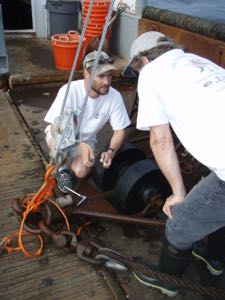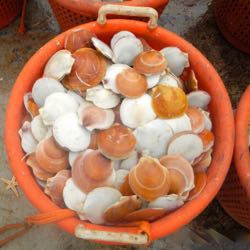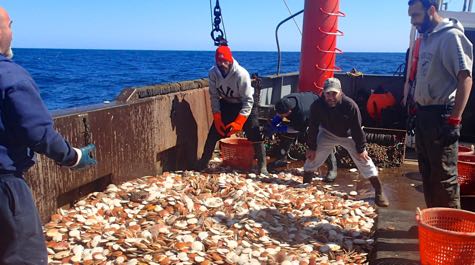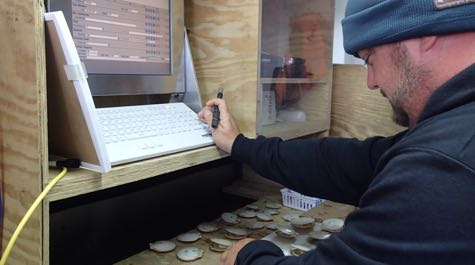VIMS earns $6M in set-aside funding for scallop research
Researchers at the Virginia Institute of Marine Science have earned nearly $6 million in set-aside funding to advance the understanding and management of sea scallops off the U.S. East Coast. These tasty bivalves support one of the nation’s highest-valued commercial fisheries.
Announced by NOAA’s Northeast Fisheries Science Center and the New England Fishery Management Council, the awards to VIMS account for 6 of the 15 research projects funded. Senior Research Scientist David Rudders is lead investigator on 5 of the 6 VIMS projects, and a co-lead on the other one.
Support for the projects comes from the 2016 Sea Scallop Research Set-Aside (RSA) program, which derives its funds by setting aside a portion of the annual sea-scallop fishery allocation to use as financial support for a competitive grant program. Unique to federal fisheries in the northeast region, RSA programs use no federal funds. Instead, successful applicants partner with the fishing industry to both conduct the research and harvest the set-aside award to generate funds for the research.
 This year, program administrators received more than 30 proposals, including half a dozen 2-year projects. The proposals were evaluated and ranked based on a two-stage review process that considered both technical merit and responsiveness to New England Fishery Management Council research priorities.
This year, program administrators received more than 30 proposals, including half a dozen 2-year projects. The proposals were evaluated and ranked based on a two-stage review process that considered both technical merit and responsiveness to New England Fishery Management Council research priorities.
Tom Murray, head of the Marine Advisory Services program at VIMS, says “David Rudders should be commended for his success in this very competitive program. Hard work by Dave, scallop industry partners, and colleagues at VIMS and other institutions continue to make the U.S. scallop fishery an international model for sustainability and public-private cooperation.”
VIMS Dean and Director John Wells says, “Our decades-long engagement in monitoring and informing management of the Atlantic sea-scallop stock is a real testament to the importance we at VIMS put on advisory service in support of sustainable commercial and recreational fisheries.”
On a sharp downward slide in the 1990s, the sea-scallop industry is now the second most valuable commercial fishery on the East Coast, with more than $400 million in scallops landed in 2014. Virginia alone unloaded $33.6 million in scallops in that year, generating an additional $21 million in economic activity in the Commonwealth for a total impact of nearly $50 million.
Virginia’s scallop fleet is based out of ports in the southern portion of Chesapeake Bay, with Newport News and Seaford being home to a large number of vessels. While based in Virginia, scallop vessels fish the continental shelf from the Bay mouth north to New England.
2016-2017 RSA projects
Overall for 2016-2017, 25 researchers from 9 different organizations in Maine, Massachusetts, New Jersey, Rhode Island, and Virginia earned RSA funding valued at $15.6 million. Award recipients include universities, non-profit organizations, and commercial fishing vessels and businesses.
Ten projects will address the Council’s highest research priorities, including intensive and broad-scale resource surveys, bycatch reduction, scallop meat quality, and scallop-area management. Five projects focus on other Council priorities, such as sea-scallop biology and productivity, habitat-impact research, and approaches to reduce the risk of sea-turtle interactions with the scallop fishery.
Resource surveys
Three of VIMS’ RSA awards will support surveys of the sea-scallop stock, and, combined with the annual sea-scallop survey by NOAA Fisheries and others, will provide a comprehensive picture of the scallop resource by the end of this summer. The data collected are expected to support the Council’s fishery specifications for 2017 and beyond.
 Specifically, VIMS and its partners will conduct a fine-scale dredge survey of the entire Mid-Atlantic sea-scallop resource from the Virginia/North Carolina border to Rhode Island, a high-resolution survey of scallop abundance and distribution in and around the Nantucket Lightship Closed Area, and a similar survey in the Georges Bank Closed Area II and the area to the south, where secondary objectives include study of finfish bycatch; monitoring of product quality and disease; and testing the performance of commercial and survey dredges.
Specifically, VIMS and its partners will conduct a fine-scale dredge survey of the entire Mid-Atlantic sea-scallop resource from the Virginia/North Carolina border to Rhode Island, a high-resolution survey of scallop abundance and distribution in and around the Nantucket Lightship Closed Area, and a similar survey in the Georges Bank Closed Area II and the area to the south, where secondary objectives include study of finfish bycatch; monitoring of product quality and disease; and testing the performance of commercial and survey dredges.
Joining Rudders on the survey projects are VIMS colleagues Sally Roman and Robert Fisher.
Sea-scallop biology, meat quality, and productivity
VIMS researchers also earned RSA funding to examine several fundamental aspects of sea-scallop biology and ecology. Professor Roger Mann will partner with Rudders to study the age structure of sea-scallop populations and the growth rates of individual sea scallops through time. Rudders and VIMS professor John Hoenig will conduct a mark-recapture field experiment to estimate natural mortality, scallop growth and movement, and the effects of scallop density on those factors.
Rudders will also collaborate with colleagues at Rutgers University to study the impacts of an emerging nematode parasite on sea scallops. Objectives for this work include understanding the life cycle of the parasite, how the distribution of the nematode changes in time and space, and its effect on scallop meat quality. The researchers hope to provide insight and guidance into how the industry and managers can assess and predict impacts to the scallop stock.
A full list of this year’s RSA projects is available online.



